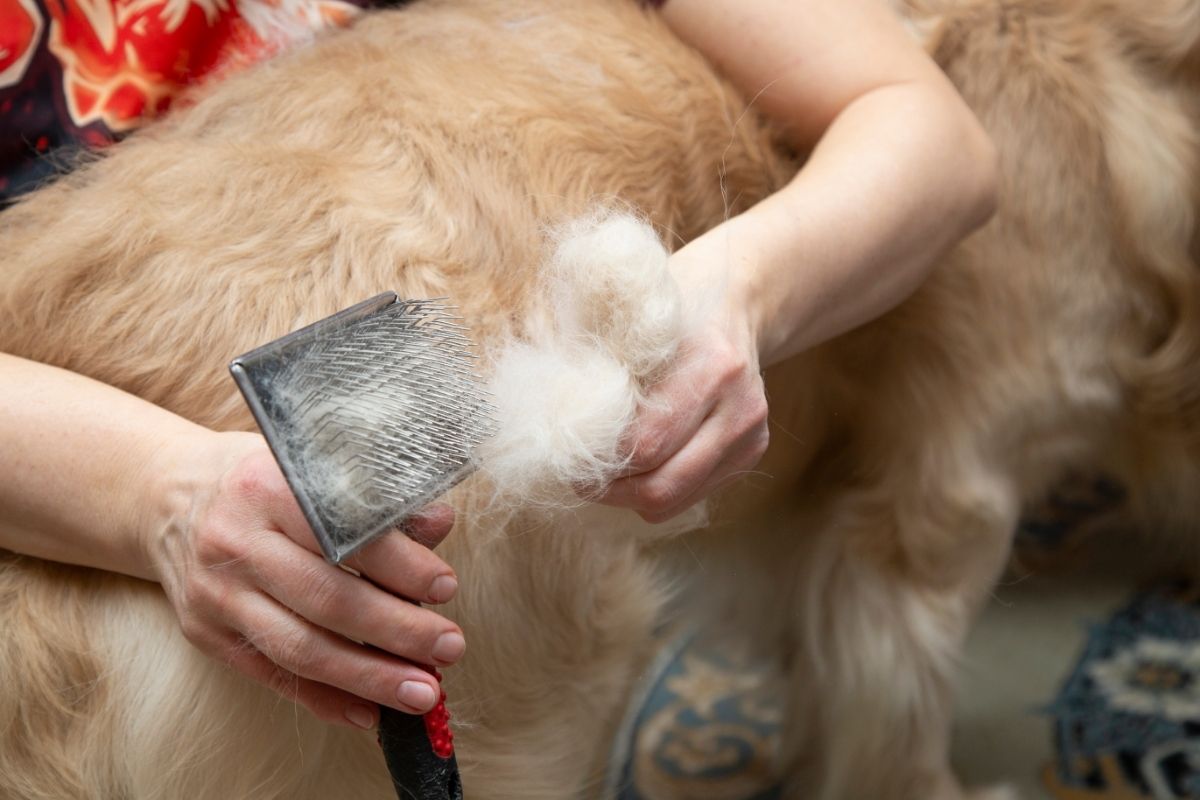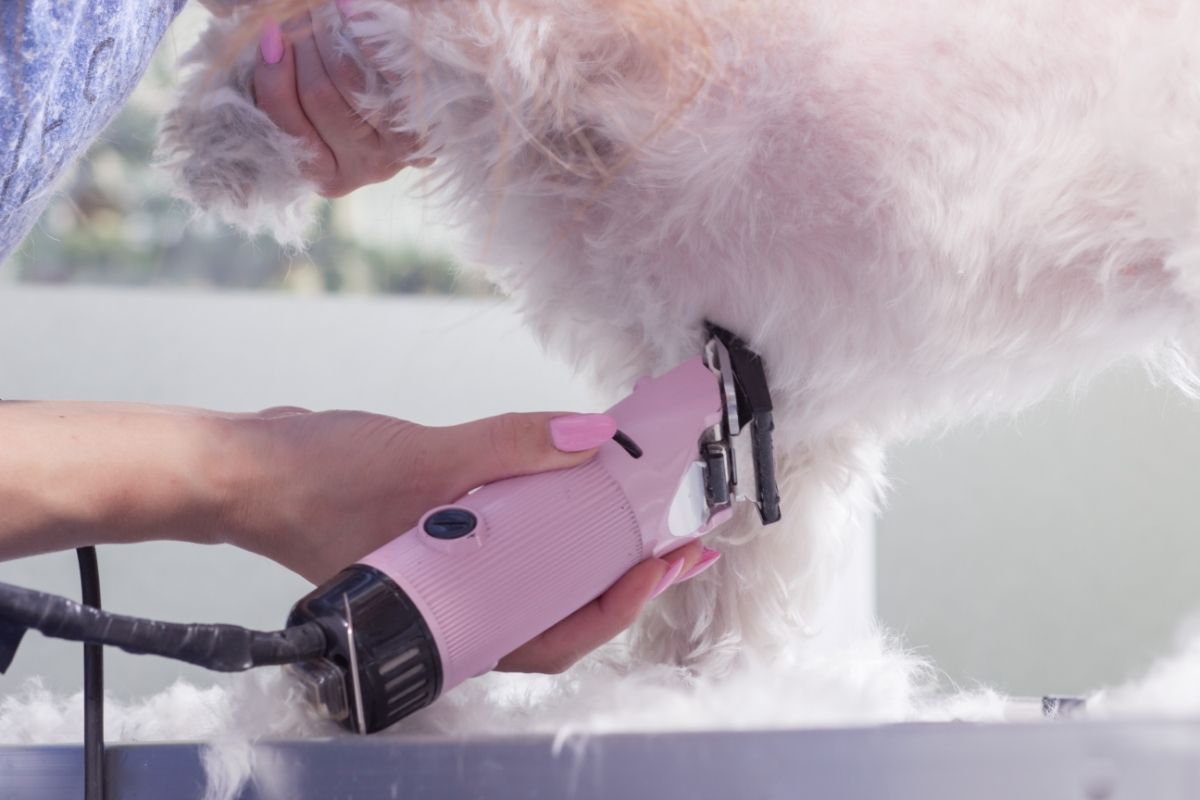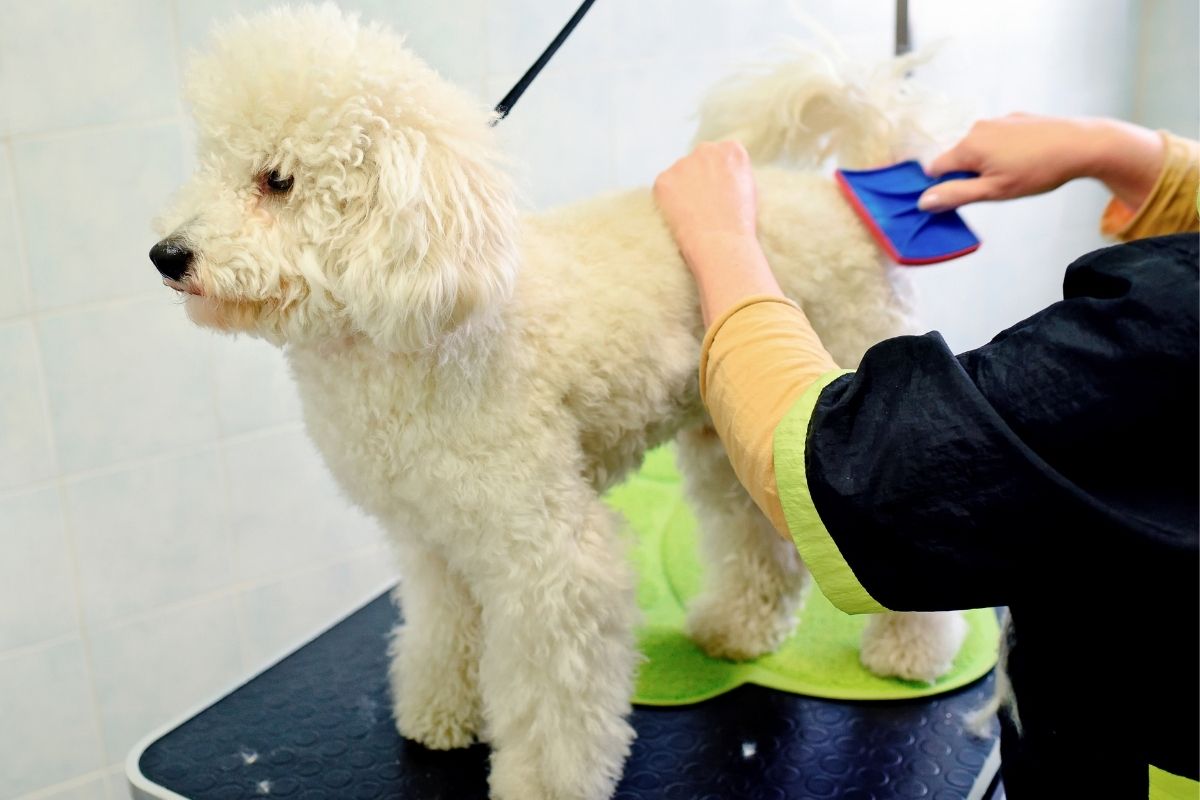Sometimes, life demands make us forget brushing our furry friends. When we get at ease, we get another challenge of dealing with severely matted dog hair. However, try to make this challenge a one-time occurrence.
Detangling matted fur is a painful exercise for a dog. Sometimes, going bald is the only option for a matted dog. Would you like to know more about matted dog hair removal? Let us explore this issue together.

Classifying Severely Matted Dog Hair
There are several types of severely matted fur. The first one develops after dead hairs gather to form a lump on a dog’s coat. It is easy to remove because you only need to loosen and brush it off.
The second type appears like dreadlocks that you can also snip out easily. You only need to place a comb between the knots’ ends and skin and trim the side with the knot. Again, the move prevents you from cutting the skin of your dog.
The third severe dog hair mat develops as a sheet cover on the fur. It looks similar to a sheep pelt.
Other forms of severe mats develop on the fur of a dog selectively. For example, dogs with a fine coat are prone to rugged mats that can form on any part of their coat. Dogs with drop coats also face a similar type of mats. However, dogs with a combination of coats develop severe mats on their rump and behind their ears.
What is Matted Fur?
Matted fur refers to fur with dense knots and tangles. This kind of fur causes pain to a dog. It can also give rise to skin irritations and infections, among other health concerns. However, matted hair can also hide some health issues and parasites.
Fur with mats blocks the inflow of air in the coat. It also traps moisture that causes sores and irritation on the dog’s skin.
When matting becomes extreme, it can cause hematomas. The condition cuts off air circulation in the fur of a dog completely. In such a case, you need to visit a veterinarian for assistance.
Some dogs have fur that is more prone to matting than other dogs. Notably, any long coat can develop mats. However, certain breeds are more at risk of getting mats than others. The vulnerable breeds include Poodles, Cocker Spaniels, and Bishon, among other breeds. In addition, Yorkies and other dogs with long silk hair or double coats are also susceptible to matting.
How to Identify Matted Fur
Sometimes, mats are invisible. They can hide under other long and straight strands of dog fur. So how can you identify them?
Run a comb through your dog’s fur to identify the matted areas. A comb that goes through the hair smoothly tells you that your dog is mat-free. However, if the comb gets stuck in the hair, your dog has mats that require immediate and planned action.
After identifying the mats, separate them from normal hairs to see their intensity. If they are loose, you can brush them off. However, tight mats require you to follow a specific procedure to remove them. Alternatively, you can take your dog to a professional groomer for attention.
Causes of Dog Knots
Friction
Matting can appear on the parts of a dog where a lot of friction occurs. For example, it can occur on the armpits when a dog is in motion. It can also appear on the parts supporting the harness or collar because the accessories rub against the fur.
Matting can also appear on the legs when a dog sits down or gets wet. Lastly, matting can occur behind the ears and other parts of a dog due to scratching.
Seasons
Matting can happen when a dog sheds hair to get a summer coat. If you do not brush your dog on time to remove the dead hair, the loose hair can remain on the fur and form mats on the new coat.
Allergies
Allergies can make the skin of your dog itch. In return, the dog can keep on scratching itself. Hair falls off during the scratching process and forms mats on the fur.
Fleas
Fleas cause itchy skin that makes your dog keep on scratching itself. If they remain on the fur, the dog can end up breaking a lot of hairs that form mats.
Water
During rainy days, dogs that go outdoors step on water. They also rub their bellies on wet ground. As a result of these actions, your dog can develop mats on its belly and legs. Dogs that love swimming are also prone to matting. If you bathe a dog with mats, the mats tighten up. That is why you should dry and brush your dog after its bath.
How to Remove Matted Dog Hair
De-matting a dog requires skills and a few tools and accessories. So, make the appropriate preparations before starting the procedure. What are the tools that you should gather first?
Shampoo
Look for a shampoo that can clean and condition the fur of your dog. Better still, you can get a shampoo that deodorizes, detangles, and moisturizes besides cleaning and conditioning.
Detangling Brush
You can opt to use regular dog brushes to detangle dog mats. However, a detangling brush can perform better than a regular brush. A detangling brush has unique features that complete the de-matting exercise efficiently. After using the detangling brush, use a gentle brush to smoothen out the fur.
Detangler Spray
A detangler spray brings a calming effect after a de-matting process. But unfortunately, the process is painful for a dog. So, bring relief to your furry friend afterward using the detangler spray.
Clippers
Avoid heavy-duty clippers when de-matting your dog. The ideal option is to use simple shears. You can get the shears as a set. One of the unique features of detangling shears is the rounded tips. It prevents you from poking or stabbing the coat of your dog. Thinning shears are also an ideal detangling option. They thin out the dog’s hair without any breakage.
The Detangling Process
Now that you know the equipment and items to get before de-matting your dog, let us discuss the procedure you should follow:
- Get your dog comfortable: You should place your dog in a position that makes him feel free. It should never feel scared and trapped because it can become fidgety. So, put your dog on a kitchen counter or any other surface that brings it to your level. You can also use your sofa for skittish or large dogs.
- Massage every knot gently before working on it: This move naturally loosens the hair before using other artificial methods.
- Set each mat apart from the surrounding hair: You should push the loose hair away from the mat to expose the mat.
- Use a soft bristle brush on the matted area: Hold the base of the mat and use alternating brushing strokes. This move tugs the skin minimally. You can also brush sideways to loosen the hair fibers.
- Detangle the mat using a de-matting comb: Start at the top of each mat and work downwards to its base. Ensure that your fingers are still holding the bottom of the mat you are detangling.
- Spray the matted area with conditioner: You should spray until the matted part becomes slightly damp. The conditioner makes the brush slide smoothly through the hair. However, this step is optional.
- Comb the detangled hair: Use a stainless steel comb or any gentle comb within your reach to comb the fresh-looking dog’s coat. Brushing allows the conditioner to spread evenly.
- Pet your dog: After the detangling process is over, give your dog some treats and speak gentle words to it. Remember, your furry friend could have felt a little pain during the detangling process, but it put up with you. So, it deserves a reward.
Alternative Detangling Methods
You can detangle mats using cornstarch, especially when you do not have time to take your dog to a professional groomer or detangle it at home. So, rub cornstarch on the mats and slick the hair from the bottom upwards using a comb.

How to Cut Extremely Matted Dog Hair
If you find that cutting the mats of your dog’s fur is the only option, feel free to do it. For example, you can follow the following procedure:
- Gather the necessary tools: You require a dog-shedding brush, comb, mat rake, electric clipper or mat splitter, detangler spray, conditioner, and shampoo. So, before you start cutting the matted fur, ensure you have the listed items.
- Identify the tangles: Use a comb to find the knots. You can opt to focus on the most vulnerable dog parts, including ears, belly, collar area, armpits, and tail.
- Spray the detangler: Spray the knots (one at a time) using the detangler solution. Massage the sprayed knot to ensure that the spray penetrates well.
- Use your fingers first: Try to loosen the hair knots with your fingers. It is a time-taking process, but it is worth the hustle. If the knots are too tight, use a mat rake. However, apply caution not to scratch the dog’s skin with the rake.
- Cut with a mat splitter: Use a mat splitter to cut through each mat into smaller portions while following the direction of hair growth. Next, use your fingers to untangle the small parts of each mat. This step applies to the stubborn mats that fail to yield to your fingers and the mat rake action.
- Brush: After ensuring that the mats are loose, spray the hair with a detangler solution. Afterward, brush each tangle to separate the hair strands. Ensure that you brush in the direction of hair growth. You can opt to add the detangler solution until the hair becomes loose.
- Bath your dog: After removing the mats, bathe your dog. Remember, water tightens the mats. So, ensure that you have untangled all mats before bathing your dog. Use the conditioner and shampoo during the bathing process. The conditioner prevents the matting of hair when drying your dog off.
Preventing Severely Matted Dog Hair
Matting is annoying and recurring dog problem. If possible, prevent it at all costs. The following are some of the strategies you can employ to reduce the recurrence of matting:
Feed Your Dog With the Right Diet
Proper nutrition maintains a dog’s cost health optimally. The diet that your dog takes should have Omega 3s. These nutrients improve the dog’s immunity and coat condition. In addition, feed your dog with animal-based oils, such as fish, krill, and salmon oil.
Animal-based oils are in usable form to your dog, unlike plant-based oils, such as corn oil. Additionally, animal-based oil inhibits the overloading of Omega 6s that causes skin allergies, inflammation, and other skin conditions in dogs.
Choose the Right Brush
The type of brush you use on your dog contributes to the prevention of matting recurrence. Use slicker brushes for long heavy-coated dogs. This brush has fine wire bristles that can bend. You can also use a pin brush during the de-matting process. It features metallic bristles in a rubber casing.
Regarding a comb, it comes in handy after the detangling process. The length of your dog’s coat determines the size and design of a comb to use. You can also use a soft-bristled brush after the detangling process.
Bathing
Your dog should be taking a bath regularly for an optimally conditioned coat and skin. There is no standard number of times that you should bathe your dog. So, do it often. This move keeps on removing dead skin and hair from the coat of your dog.
Putting shampoo and conditioner on a dog’s bath keeps its skin and coat healthy. However, never use human products when bathing your dog. They make the skin of a dog dry and flaky.
Brushing
Regularly brushing your dog is an apt way of keeping mats off the grid. It also exfoliates the dog’s skin. During the brushing process, use a detangling or moisturizing spray to eliminate static electricity that causes matting. You should also remove the dog’s collar and brush small sections of the dog’s coat one at a time until you cover the entire body.
Often, most dog lovers brush the back of a dog more than other parts of the body. The back is the easiest part to brush, and it can make you forget the other body parts of your dog. Remember, mats also develop at the back of the dog’s ears and legs. So, ensure that you cover all aspects of the dog’s body when brushing it.
Keep the Dog’s Hair at a Manageable Length
Clip the hair of your dog after every four to six weeks. Doing so keeps the hair at a manageable level. In addition, such hair is easy to brush and maintain.

Summary
Mats can form on any part of your dog. The most vulnerable parts have long hair. Also, the belly, back of the ears, and armpits are areas prone to matting. Regular grooming and brushing keep mats off your dog’s coat. However, mats have a way of coming back unannounced. So, you have to make it a habit to run a comb through the hair of your dog often.
You can opt to de-mat at home or take your furry friend to a professional groomer for de-matting. However, detangling mats is complex and can take a lot of time. So, you require skills, patience, and the right tools and accessories to carry out the process successfully.
Remember, every dog is prone to matting. So, ensure that you do not take too long to take your dog for grooming. Better still, always create time to check and address mats to keep the health of your dog’s skin and coat in perfect condition. Also, remember the following tips:
- Train your dog to tolerate the de-matting process at an early age. If you do so, your dog will become accustomed to the matting process and stop being nervous during the process.
- Focus on the ears, legs, armpits, and underbelly when looking for fur mats. These are some of the parts that experience a lot of friction that causes matting.
- Use a detangler spray or cream to keep mats off your dog’s fur. It gives pain relief to the dog after a de-matting process. It also softens the hair strands and makes the de-matting process easy.
- Take a severely-matted dog to your veterinarian or a professional groomer. Know that de-matting a severely matted canine is a complex process. The process requires care, skills, and unique equipment. A professional groomer meets the three requirements and makes the de-matting process smooth.
- Get advice on the best dog brush for matted hair and the brushing technique to use on your dog from your groomer. Different brushes befit different types of dog coats and hair lengths. Asking for advice from a groomer enables you to make an informed decision when buying a brush for your dog.
- Remember to clip the sanitary parts of your dog. The move improves the sanitary hygiene of your dog. Also, it keeps your households clean, especially the sofa that you share with your furry friend.
- A diet with Omega 3s is a necessity for your dog. It helps to maintain the health condition of your dog’s skin and prevent matting. Remember, animal-based oils are better than plant-based oils when it comes to the provision of Omega 3s.
After drawing lessons from this discussion, your furry friend will never have mats again. You are now a pro in de-matting and detangling the fur of your dog. You can also shop for all requirements that make de-matting successful. Finally, it is time to draw a schedule of how and when you will be carrying out the process.

